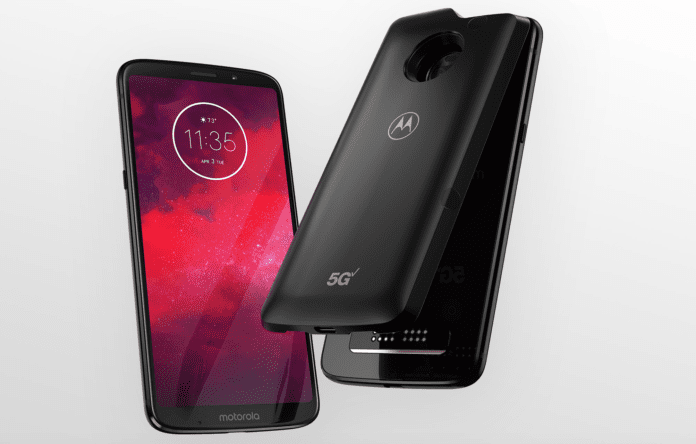If you are in the telecom world and have not heard about the recent announcement of the Motorola z3, and more importantly, its Moto Mod 5G add-on, you must be hiding under a rock. Jointly announced by Verizon (NYSE: VZ) and Lenovo (HKSE: 0992.HK), this is officially the first 5G-upgradable smartphone and is set to start off the 5G device parade. Remember, Qualcomm (NADAQ: QCOM), the chipset vendor behind this phone, is said to be working with almost 20 OEMs.
The Motorola z3 is a flagship phone built around powerful Snapdragon 835 SoC, with integrated Snapdragon X16 modem. The Mod has Snapdragon X50 modem and four QTM052 millimeer wave (mmWave ) antenna modules.
Apart from getting all the well deserved credit for many “firsts,” the phone and the Moto Mod busts many myths about 5G smartphones. Especially, the conventional beliefs developed based on the experience of 4G:
1. 5G is still a concept and commercialization is years away
So far, there has been this frenzy about the capabilities and promise of 5G, and how it will change everything. There was also a lot of news about demos, trials, deployment plans and commitments. But nothing that looked like a commercial device or something that somebody could hold in their hand and say “this is it.” Well, Moto Mod announcement changed all that. The lucky few even got to touch and feel it in their hands.
2.The first 5G devices will be fixed wireless terminals, 5G smartphones will come much later
To the surprise of all the people who follow 5G closely, Lenovo and Verizon pulled a fast-one in announcing this device. I am sure the first fixed 5G terminals are very close to being announced as well. But they lost the world’s first commercial 5G device “crown.” So, when our grand children study about wireless history and 5G in the future, the Moto Mod will be shown, similar to how we see Martin Cooper’s legendary mobile phone as the first one.
3. The 5G smartphones will start with super expensive premium tier and will take years before reaching the mainstream
Well, we don’t know the pricing of the 5G Mod yet, but the host phone that it will go with is priced at around $500, which places it solidly in the mid-rage. So, when it gets out of the gate, the luxuries and the benefits of 5G will not be just for the rich and fancy, but also for the average Joe.
4. 5G mmWave is a pipe dream, it will take years to really put it in smartphones
The utility and the possibility of mmW in smartphones have been a perennial question for the skeptics. No matter how demos and trials you show, nothing allies those fears more than holding a commercial device in your hand. Nobody expected that only two weeks after the announcement of 5G mmW modules, you would see a commercial device with all its glory in the public domain. This goes to show that mmW is just not some abstract concept, but a working technology with commercial design.
5. The first 5G smartphones will be bulky, heavy and battery killers
With the novel idea of add-on mod, Lenovo has solved many of the complexities associated with designing a mmW 5G phone. In size, the mod is slightly bigger than today’s juice packs (battery packs). We don’t yet know the actual battery-life of the device. But knowing that the mod has built in battery, the impact of 5G on the battery-life should be manageable.
6. Who would want to carry the early 5G smartphones, as they will be bulky and the 5G coverage will be sparse
Lenovo, with the “Mod” approach, has very effectively addressed the concern of carrying a bulky phone everywhere, whether you need 5G or not. You simply snap on the mod when you are in the mmW 5G coverage, snap off and keep in your pocket or bag, when you are not. For the skeptics who say that carrying this thing all the time is such an inconvenience, I say, look at how many people carry their juice packs (portable battery packs). This is no different.
7. 5G is needed for all those exotic apps such as AR/VR headsets, drones, robotics and others as well as fixed wireless broadband. There are no killer use cases for 5G smartphones
In our view, in the early days, capacity is the killer use case for 5G. And most of that capacity is needed for smartphones. Verizon going with this mid-range phone for 5G is reinforcing that fact. They would want 5G smartphone penetration to quickly ramp-up so that they can support all that traffic economically, Because 5G has far lower cost-per-bit to haul traffic than 4G.
8. 5G is all hype, without a strong use case and business case, the hype will soon wither out
In our view, capacity is the killer use case and competitive pressure is the killer catalyst for 5G. This was very evident with this announcement. Operators and vendors are going overboard and announcing products early to show their market leadership. For example, this Mod announcement is almost six 6 months before it’s in stores. This is unheard of in the smartphone market before. We would be really surprised, if AT&T doesn’t come with their device announcement very soon, just to counter Verizon’s perceived leadership. So, it is this competitive pressure that will push the industry participants and create traction for 5G.
Bringing a new technology through add-ons has been a time-tested practice in the computing space. We have seen many new technologies appearing in USB dongles before being integrating in to the PC/laptops. The same is being tested for the first time in the smartphone world. How well this device will sell is anybody’s guess at this moment. No matter what happens with the actual sales numbers, 5G Moto Mod has indeed claimed its rightful place in the 5G history book.

